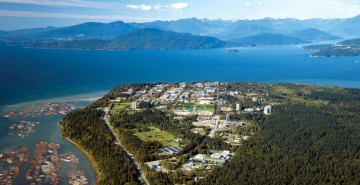 Only 30 minutes from the heart of downtown Vancouver, the University of British Columbia holds an international reputation for excellence in advanced research and learning.
Only 30 minutes from the heart of downtown Vancouver, the University of British Columbia holds an international reputation for excellence in advanced research and learning.
The spectacular UBC campus is a ‘must-see’ for any visitor to the city – where snow-capped mountains meet ocean, and breathtaking vistas greet you around every corner.
The university boasts some of the city’s best attractions and recreation facilities, including the Museum of Anthropology, the Chan Centre for the Performing Arts, the UBC Botanical Garden, and endless opportunities to explore forested trails in the adjoining 763-hectare Pacific Spirit Regional Park. (Excerpt from the UBC website.)
Vancouver
It’s one of the most remarkable cities you’ll ever visit. Vancouver sits at the edge of the Pacific Ocean. Nestled snugly in and around the slopes of snow-capped Coast Mountains. Where your need for the city is satisfied. Your yearning for nature is indulged.
Hike one of three local mountains in the morning. Or walk on one of 16 beaches. Sail in the afternoon. Or stroll part of the 1000-acre Stanley Park downtown.
In the evening, stroll Robson Street or visit the bistros on Granville Island. Tour the Vancouver Aquarium Marine Science Centre, Maritime Museum, or Vancouver Art Gallery.
British Columbia and Area
![By Alan Wu (Fairweather rangeUploaded by Aconcagua) [CC-BY-SA-2.0], via Wikimedia Commons](https://lfs-wine-collab.sites.olt.ubc.ca/files/2011/07/800px-Fairweather_range-360x240.jpg) The population is heavily concentrated in the metropolitan areas of Victoria and Vancouver.
The population is heavily concentrated in the metropolitan areas of Victoria and Vancouver.
- Population: 4.5 million (concentrated in Vancouver, population 2.3 million, and Victoria, population 368,000)
- Canada’s third most populated province (after Ontario and Quebec)
- Only province in Canada to experience a “West Coast special“: ski and golf in the same day
- Westernmost of Canada’s 10 provinces
The climate and topography of British Columbia varies greatly, influenced by latitude, the province’s mountains and distance from the Pacific Ocean. This diversity causes wide variations in average hours of sunshine, rainfall, snow and temperatures, sometimes over remarkably short distances.
In summer, temperatures in B.C.’s interior frequently surpass 30 degrees Celsius (86 degrees Fahrenheit); nearer the coast and in other regions, readings will range from 23 to 28 degrees Celsius (73 to 83 degrees Fahrenheit).
In winter, the Lower Mainland and Greater Victoria enjoy a temperate climate, and if snow falls, it doesn’t stay long. But wrap up warmly if you’re heading for Whistler, the interior, or Northern British Columbia.
British Columbia boasts a diverse population with a plethora of cultures, languages and customs. As Canada’s gateway to the Pacific Rim, the province has a thriving Asian population (North America’s third largest Chinatown is found in Vancouver) while German, Italian, Japanese, British, Russian, East Indian and other ethnic groups provide a mosaic of distinctive cuisine, architecture, decorative gardens, arts, religious ceremonies and much more.
And, of course, there’s British Columbia’s aboriginal heritage. Representing about five per cent of the province’s total population (approximately 170,000), this unique aspect of B.C. offers visitors a particularly rich cultural experience province-wide, through interpretive sites, tours and art exhibitions.
Credit for text: Tourism British Columbia.